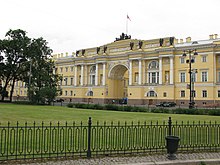Holy Governing Synod
| Святейший Правительствующий Синод | |

Headquarters of the Holy Synod of the Russian Empire in St. Petersburg
|
|
| Formation | January 25, 1721 |
|---|---|
| Founder | Peter I of Russia |
| Extinction | 1918 |
| Type | Governing body |
| Purpose | Highest governing body of the Russian Orthodox Church |
|
Region
|
Russia |
|
Membership
|
10-12 |
The Most Holy Governing Synod (Russian: Святейший Правительствующий Синод) was the highest governing body of the Russian Orthodox Church between 1721 and 1918 (when the Church re-instated the Patriarchate). The jurisdiction of the Most Holy Synod extended over every kind of ecclesiastical question and over some partly secular matters.
Peter I of Russia established the Synod on January 25, 1721 in the course of his church reform. Its establishment was followed by the abolition of the Patriarchate. The Synod was composed partly of ecclesiastical persons, partly of laymen appointed by the Tsar. Members included the Metropolitans of Saint Petersburg, Moscow and Kiev, and the Exarch of Georgia. Originally, the Synod had ten ecclesiastical members, but the number later changed to twelve.
A series of reforms by Peter the Great inspired the creation of the Most Holy Synod. The new Imperial Age saw radical change and developments in economic, social and cultural aspects of Russian life. Peter traveled twice to Europe and made reforms that reflected his desire to westernize Russia and worked to Russify the European models to better fit his nation. Beyond forming the Synod in an effort to enfeeble the power and authority of the Russian Orthodox Church, he also challenged traditional Russian values, which were rooted in religion and a social structure defined by boyars and aristocracy, merchants, clerics, peasants and serfs. He did so by implementing enlightenment ideals--except for any that would have resulted in democratizing the Russian government, tolerating political or religious dissent, or encouraging the free growth of thought or ideas; establishing the Julian calendar; reorganizing the Russian army in the European style; establishing a meritocracy (as opposed to the previous system of delineating positions by aristocratic lineage); outlawing or taxing beards (which were common among the Old Believers); etc. Peter’s desire for the consolidation and standardization of authority led to the creation of the Synod. With one leader (the patriarch) the church proved too great of a threat to Peter’s rule, and he was unwilling to share power.
...
Wikipedia
